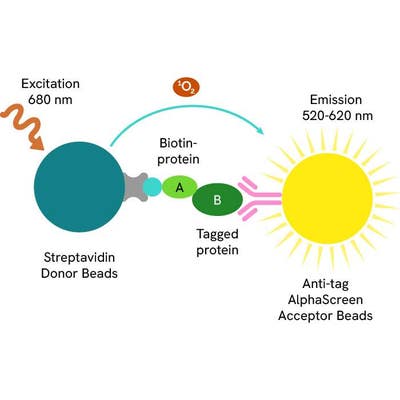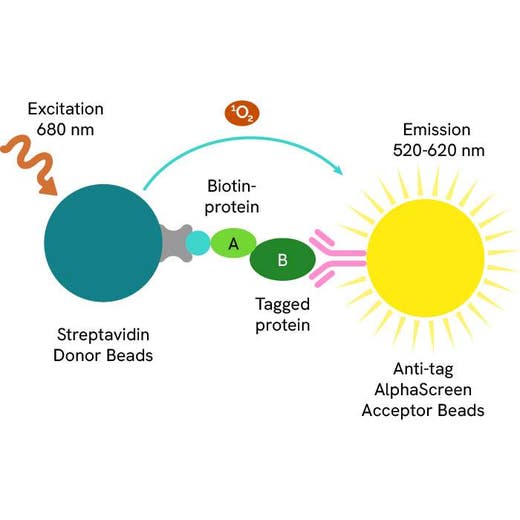
AlphaScreen DIG Detection Kit, 50,000 Assay Points


 View All
View All
AlphaScreen DIG Detection Kit, 50,000 Assay Points










AlphaScreen® no-wash assay kit containing Streptavidin Donor beads and Anti-Dig (digoxin) conjugated AlphaScreen Acceptor beads.
For research use only. Not for use in diagnostic procedures. All products to be used in accordance with applicable laws and regulations including without limitation, consumption and disposal requirements under European REACH regulations (EC 1907/2006).
| Feature | Specification |
|---|---|
| Application | Protein-Protein Interaction |
AlphaScreen® no-wash assay kit containing Streptavidin Donor beads and Anti-Dig (digoxin) conjugated AlphaScreen Acceptor beads.
For research use only. Not for use in diagnostic procedures. All products to be used in accordance with applicable laws and regulations including without limitation, consumption and disposal requirements under European REACH regulations (EC 1907/2006).





AlphaScreen DIG Detection Kit, 50,000 Assay Points





AlphaScreen DIG Detection Kit, 50,000 Assay Points





Product information
Overview
This kit contains enough reagents to run 50,000 wells in 384-well format, using a 25 µL reaction volume.
This bead kit can be used for many applications, including:
- Protein-protein interaction assays
- Protein-peptide interaction assays
- DNA-protein interaction assays
- RNA-protein interaction assays
- Dig tagged protein detection and quantitation
- Protein expression
- Binding studies
In a typical AlphaScreen assay, one biomolecule of interested is biotinylated and associates with the Streptavidin-coated Donor beads. The other biomolecule is Dig-tagged, and associates with the AlphaScreen anti-Dig Acceptor beads. If the two biomolecules bind to each other, the Donor and Acceptor beads are brought into proximity. Excitation of the Donor beads causes the release of singlet oxygen, which diffuses and triggers the emission of light from the Acceptor beads when in proximity. The amount of light is directly proportional to the degree of interaction. Competition formats are also possible, using the biotinylated Dig probe provided in the kit.
AlphaScreen® and AlphaLISA™ are bead-based assay technologies used to study biomolecular interactions in a microplate format. The acronym ""Alpha"" stands for amplified luminescent proximity homogeneous assay. As the name implies, some of the key features of these technologies are that they are non-radioactive, homogeneous proximity assays. Binding of molecules captured on the beads leads to an energy transfer from one bead to the other, ultimately producing a luminescent/fluorescent signal. To understand how a signal is produced, one must begin with an understanding of the beads. AlphaScreen and AlphaLISA assays require two bead types: Donor beads and Acceptor beads. Each bead type contains a different proprietary mixture of chemicals, which are key elements of the AlphaScreen technology. Donor beads contain a photosensitizer, phthalocyanine, which converts ambient oxygen to an excited and reactive form of O2, singlet oxygen, upon illumination at 680 nm. Please note that singlet oxygen is not a radical; it is molecular oxygen with a single excited electron. Like other excited molecules, singlet oxygen has a limited lifetime prior to falling back to ground state. Within its 4 µsec half-life, singlet oxygen can diffuse approximately 200 nm in solution. If an Acceptor bead is within that proximity, energy is transferred from the singlet oxygen to thioxene derivatives within the Acceptor bead, subsequently culminating in light production at 520-620 nm (AlphaScreen) or at 615 nm (AlphaLISA). In the absence of an Acceptor bead, singlet oxygen falls to ground state and no signal is produced. This proximity-dependent chemical energy transfer is the basis for AlphaScreen's homogeneous nature.
Specifications
| Application |
Protein-Protein Interaction
|
|---|---|
| Automation Compatible |
Yes
|
| Brand |
AlphaScreen
|
| Conjugates |
Streptavidin/Anti-DIG
|
| Detection Modality |
Alpha
|
| Host Species |
Human
|
| Product Group |
Kit
|
| Shipping Conditions |
Shipped in Blue Ice
|
| Target Class |
Binding Assay
|
| Technology |
Alpha
|
| Unit Size |
50,000 Assay Points
|
Video gallery

AlphaScreen DIG Detection Kit, 50,000 Assay Points

AlphaScreen DIG Detection Kit, 50,000 Assay Points

Resources
Are you looking for resources, click on the resource type to explore further.
Alpha has been used to study a wide variety of interactions, including protein:protein, protein:peptide, protein:DNA, protein:RNA...


How can we help you?
We are here to answer your questions.






























